Lesson 2
THE
SOURCE:
DESIGN
OR CHANCE?
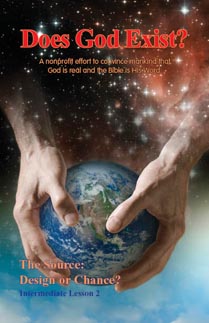 In our previous
lesson, we saw how the scientific evidence interrelates to
choices atheists and believers must make about the creation.
As stated, we assume that the student understands we are
talking about the weight of the evidence, not absolute proof.
We assumed that you accept the fact that there is reality and
that you do exist. We then looked at the choices about that
existence. The evidence supports the fact that there was a
beginning. Scientific conservation laws demand that this
beginning must have been caused. The diagram below gives a
graphic representation of these choices.
In our previous
lesson, we saw how the scientific evidence interrelates to
choices atheists and believers must make about the creation.
As stated, we assume that the student understands we are
talking about the weight of the evidence, not absolute proof.
We assumed that you accept the fact that there is reality and
that you do exist. We then looked at the choices about that
existence. The evidence supports the fact that there was a
beginning. Scientific conservation laws demand that this
beginning must have been caused. The diagram below gives a
graphic representation of these choices.
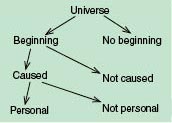 The final
question in this logical sequence is "What was the cause?" If
the cause was a personal God, there are certain attributes
that should appear in the creation. We should see order,
design, intelligence, purpose, and planning all around us. In
sharp contrast to this view, the atheist position maintains
there is no such thing as a personal God who created the
cosmos. If this is the case, then the universe is totally the
product of chance. There is no design, no purpose, no
intelligence, no planning--everything is the result of rote
mechanistic, opportunistic chance. The quotations of Dawkins
and Huxley in Lesson 1 express this viewpoint very well.
The final
question in this logical sequence is "What was the cause?" If
the cause was a personal God, there are certain attributes
that should appear in the creation. We should see order,
design, intelligence, purpose, and planning all around us. In
sharp contrast to this view, the atheist position maintains
there is no such thing as a personal God who created the
cosmos. If this is the case, then the universe is totally the
product of chance. There is no design, no purpose, no
intelligence, no planning--everything is the result of rote
mechanistic, opportunistic chance. The quotations of Dawkins
and Huxley in Lesson 1 express this viewpoint very well.
There is an amazing contrast between the position of
the believer in God and the atheist on the question of origins
as we will see in this lesson.
INTUITIVE DESIGN FEATURES IN THE
COSMOS
There are a myriad of things that man can see all around him
which show design and planning, but which we cannot analyze
mathematically. The incredible migratory journeys of butterflies,
birds, eels, whales, fish, and many other forms of life are
accomplished by a bewildering array of devices and techniques.
Migrations are beautifully designed not only in their
accomplishment, but also in the ecological benefits they provide.
Reproduction of all kinds demonstrates wisdom and planning.
A skeptic will react to this kind of example with the
statement that we are using a "god of the gaps." When our
knowledge improves, we will be able to explain these phenomena
just as other mysteries of nature have been explained by
scientists in the past. The complexity of the things we have
referred to makes such a statement unlikely, but the point is
well taken that “whiz bang’’ appeals have their limitations.
For that reason, let us look at some statistical evidence
which is of a different nature.
CAN A PLANETARY SYSTEM SUITABLE FOR
LIFE OCCUR BY CHANCE?
Let us make the assumption that the cosmos began by a
big bang--by chance alone. At this point we are not interested
in what banged or who caused the bang--let us simply assume
that it happened. Now let us ask this question: What are the
mathematical probabilities that ANY KIND of life (not
necessarily ours) could occur by chance alone from the big
bang or expansion?
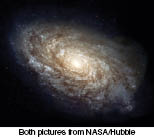 Notice that this
is not an ad-hoc argument. We are not saying we are here--what
are the odds of us being here? (This would be logically
invalid.) We are saying let's go back before the big bang and
ask, "What are the mathematical probabilities that any kind of
life on any kind of functional planet could occur by chance
alone?"
Notice that this
is not an ad-hoc argument. We are not saying we are here--what
are the odds of us being here? (This would be logically
invalid.) We are saying let's go back before the big bang and
ask, "What are the mathematical probabilities that any kind of
life on any kind of functional planet could occur by chance
alone?"
There are a myriad of factors that have to be "right"
for any kind of life to exist. One of those factors is the
kind of galaxy in which we are located. The galaxy in the
picture to the right is the kind of galaxy in which we live.
It is known as a spiral galaxy type b. What that means is that
we have a certain shape, a great deal of interstellar
material, stars of a certain age, and so forth. Interestingly
enough, our galaxy is a very rare kind of galaxy in space.
Eighty percent of all galaxies in space are of a different
type, such as the galaxy in the picture to the left. This is
an elliptical galaxy. There are 10 basic types of elliptical
galaxies plus a variety of dwarf elliptical galaxies. These
galaxies contain no interstellar material to speak of, so
there is nothing from which to make terrestrial planets. How
can we realistically talk about life existing in a galaxy
where there are no planets?
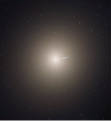 The stars in
elliptical galaxies are young and hot, totally unable to
produce any kind of a life-supporting planet. In addition,
there are barred-spiral galaxies, irregular galaxies, Seyfert
galaxies, and various other types and subtypes--all of which
have conditions that would destroy any kind of life. What are
the mathematical probabilities of having the right kind of
galaxy by chance alone? There are approximately 20 different
kinds of galaxies, but only one type could reasonably be
believed to contain any kind of life-supporting planet. The
odds could conservatively be one out of 20--ignoring the
relative number of each type of galaxy present.
The stars in
elliptical galaxies are young and hot, totally unable to
produce any kind of a life-supporting planet. In addition,
there are barred-spiral galaxies, irregular galaxies, Seyfert
galaxies, and various other types and subtypes--all of which
have conditions that would destroy any kind of life. What are
the mathematical probabilities of having the right kind of
galaxy by chance alone? There are approximately 20 different
kinds of galaxies, but only one type could reasonably be
believed to contain any kind of life-supporting planet. The
odds could conservatively be one out of 20--ignoring the
relative number of each type of galaxy present.
Another factor that is critical to the existence of
life is our location in the galaxy. A cross-section of our
galaxy is shown below.
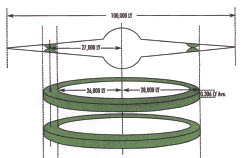 Any solar system
located along the equator of the galaxy would have a very low
probability of long term survival. Not only is there a high
concentration of matter along the equatorial axis, but the
gravitational force of that matter is higher. Collisions are
much more likely and gravitation, magnetic, and electrical
forces that can disturb the stability of a solar system are
also greater. The green area of the galaxy cross-section
picture represents a "safe" area where a solar system could
exist for a very long time in stability. This is called the
Galactic Habitable Zone (GHZ) by astronomers. What are the
mathematical odds of being in a GHZ? To determine this, we
simply divide the volume of the shaded area by the volume of
the whole galaxy. The safe "doughnut" above and below the
equatorial plane has been estimated by some astronomers to
have a one-in-a-million ratio to the volume of the whole
galaxy, so the odds of being in the right place by chance
could be a comparable figure.
Any solar system
located along the equator of the galaxy would have a very low
probability of long term survival. Not only is there a high
concentration of matter along the equatorial axis, but the
gravitational force of that matter is higher. Collisions are
much more likely and gravitation, magnetic, and electrical
forces that can disturb the stability of a solar system are
also greater. The green area of the galaxy cross-section
picture represents a "safe" area where a solar system could
exist for a very long time in stability. This is called the
Galactic Habitable Zone (GHZ) by astronomers. What are the
mathematical odds of being in a GHZ? To determine this, we
simply divide the volume of the shaded area by the volume of
the whole galaxy. The safe "doughnut" above and below the
equatorial plane has been estimated by some astronomers to
have a one-in-a-million ratio to the volume of the whole
galaxy, so the odds of being in the right place by chance
could be a comparable figure.
 The kind
of star that we orbit also is critical to the survival of any
kind of life in a solar system. Our sun is an unusually small,
cool, stable star with just the right kind of electromagnetic
emissions. Most stars in space are bigger, have a different
temperature, give off the wrong kind of light (such as
microwaves or X-rays), and/or are irregular in behavior. The
Hertzsprung-Russell Diagram shown on the next page plots the
luminosity of the star against the temperature of the star.
Every star in space can be plotted on the diagram, but only a
very small number have the right mass, size, age, kinds of
radiation, and the like, to support any kind of life. There
are massive numbers of different types of stars in space yet
only a star like our sun can reasonably be believed to support
any kind of life. What are the odds of getting the right kind
of star by chance alone? You could conservatively estimate the
odds to be one in a thousand.
The kind
of star that we orbit also is critical to the survival of any
kind of life in a solar system. Our sun is an unusually small,
cool, stable star with just the right kind of electromagnetic
emissions. Most stars in space are bigger, have a different
temperature, give off the wrong kind of light (such as
microwaves or X-rays), and/or are irregular in behavior. The
Hertzsprung-Russell Diagram shown on the next page plots the
luminosity of the star against the temperature of the star.
Every star in space can be plotted on the diagram, but only a
very small number have the right mass, size, age, kinds of
radiation, and the like, to support any kind of life. There
are massive numbers of different types of stars in space yet
only a star like our sun can reasonably be believed to support
any kind of life. What are the odds of getting the right kind
of star by chance alone? You could conservatively estimate the
odds to be one in a thousand.
The planet on which we live also offers conditions
critical to our survival. Any kind of life will have to have
the right kind of planet. The distance to the sun is critical
to the existence of water and many other compounds needed for
life. The size of the planet determines its atmospheric
makeup. The rotation rate, the existence of a magnetic field,
the structure of the atmosphere, and a myriad of other factors
are all critical for the existence of any kind of life.
In addition to all of these factors, we have to consider the odds
of being in the right place in space. If a black hole were located
in the neighborhood of the earth or any other life-supporting
planet, it would make life a total impossibility and would likely
destroy both the planet and its sun.
Chemical problems also exist in the development of
any kind of life. The existence of water is critical for life
to exist. It seems there are literally hundreds of conditions
that have to be “right” for any kind of life to exist
anywhere.
When we look at odds such as one-in-a-million, or
one-in-a-thousand, or even one-in-a-hundred, we can see that the
probabilities are low. But there are billions of stars in space
and there may be billions of planets as well. If there are enough
places out there, it will happen! All we need are enough places
and enough time and the situation will ultimately be right. We
have already mentioned in our discussion that there are a very
large number of stars in space. Our galaxy alone contains some 100
billion stars (1010).
It
has been estimated that there may be millions of galaxies (106).
Even
if
there were billions or hundreds of billions of galaxies, we are
talking about something on the order of a maximum of 1020
stars. Is this enough to allow any kind of life to come into
existence by chance alone?
You might look at the probabilities that we have
identified in our previous discussion which are summarized in
the table below and say, "Yes, the odds of each of those
events is way below a number like one in 1020."
That is certainly true, but there is another mathematical
point that we have not yet discussed.
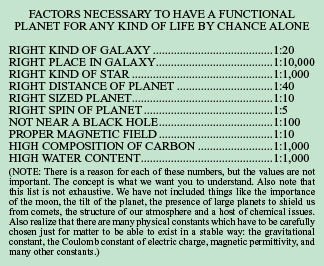
Let me illustrate by a very simple example. Suppose
that I were to hold out a deck of well-shuffled playing cards
to you and ask you to draw a single card blindfolded. What
would be the mathematical odds of drawing the ace of spades?
One in 52 is the correct answer. Now suppose that I told you
to draw twice and to draw the ace of spades each time. What
would be the odds of successfully doing that? If you are
familiar with the mathematics of this situation, you know that
the odds are 1 out of 52 times 1 out of 52.
1/52
x
1/52
= 1/2,704
When you have two events that must both be successful
to obtain a desired result, you multiply the probabilities of
each event. To draw the ace of spades out of a shuffled deck
four times in a row back to back would be:
1/52
x
1/52
x 1/52 x 1/52 = 1/7,311,616
In other words, the total probability increases logarithmically
as we increase the number of variables that have to be considered
for a successful conclusion.
The application of this mathematical principle to the
table should be obvious. It does no good to be in the right
kind of galaxy if you are in the wrong place in that galaxy.
It does no good to be in the right kind of galaxy and in the
right place in that galaxy if you are going around the wrong
kind of star or are too close or too far from that star. In
other words, every one of the conditions in the table would
have to be right. What you have to do then is to multiply the
parameters listed in the table plus the hundreds that have not
been included. Just using the numbers in the table
(conservative and very incomplete though they are) we would
get:
1/20
x
1/10,000
x 1/1,000 x 1/40 x 1/10 x 1/5 x 1/100 x 1/10 x 1/1,000 x
1/1,000 = 1/4 X 1020 in round numbers.
All of this is to get A BALL OF ROCK IN THE RIGHT PLACE! Now we
would have to multiply this number by the odds of life occurring
by chance alone! Scientists and mathematicians like Murray Eden of
MIT, Fred Hoyle of Cambridge, Francis Crick (co-discoverer of the
structure of DNA), and others have shown that the odds of getting
life by chance according to the models of Stanley Miller, Sidney
Fox, and others are in the order of 101000! Their
computations use the same concepts that we have developed in this
lesson. Even a philosopher like Antony Flew, who was a champion of
atheism, has admitted that life of any kind is not possible by
chance alone. WE ARE NOT THE PRODUCT OF CHANCE!
SUMMARY
As we have seen, the atheistic faith that matter is eternal is
impossible to believe from a scientific standpoint (Lesson 1). We
have seen that it is illogical to believe that the beginning was
uncaused because it forces us to accept the idea that matter can
come from nothing, which invalidates all of science. We have seen
that the caused beginning cannot logically or mathematically be a
product of chance. It is statistically impossible to believe that
the myriad of conditions necessary for any kind of life to occur
could happened by chance. There is intelligence, purpose, design,
order, and direction in the cosmos which speaks of a personal
intelligence.
What must this personal intelligence be like? Are we
talking about "the old engineer in the sky?" What properties
are required of this intelligence and is there any religious
belief system that is in accord with this concept? That is the
subject of our next lesson.
© 2009, John N. Clayton
Lesson 2 cover picture: iStockphoto.com/cglade
Lesson 2 Questions
Return to the Main
Page for the Intermediate Correspondence Course.
12/15/2011
 In our previous
lesson, we saw how the scientific evidence interrelates to
choices atheists and believers must make about the creation.
As stated, we assume that the student understands we are
talking about the weight of the evidence, not absolute proof.
We assumed that you accept the fact that there is reality and
that you do exist. We then looked at the choices about that
existence. The evidence supports the fact that there was a
beginning. Scientific conservation laws demand that this
beginning must have been caused. The diagram below gives a
graphic representation of these choices.
In our previous
lesson, we saw how the scientific evidence interrelates to
choices atheists and believers must make about the creation.
As stated, we assume that the student understands we are
talking about the weight of the evidence, not absolute proof.
We assumed that you accept the fact that there is reality and
that you do exist. We then looked at the choices about that
existence. The evidence supports the fact that there was a
beginning. Scientific conservation laws demand that this
beginning must have been caused. The diagram below gives a
graphic representation of these choices. The final
question in this logical sequence is "What was the cause?" If
the cause was a personal God, there are certain attributes
that should appear in the creation. We should see order,
design, intelligence, purpose, and planning all around us. In
sharp contrast to this view, the atheist position maintains
there is no such thing as a personal God who created the
cosmos. If this is the case, then the universe is totally the
product of chance. There is no design, no purpose, no
intelligence, no planning--everything is the result of rote
mechanistic, opportunistic chance. The quotations of Dawkins
and Huxley in Lesson 1 express this viewpoint very well.
The final
question in this logical sequence is "What was the cause?" If
the cause was a personal God, there are certain attributes
that should appear in the creation. We should see order,
design, intelligence, purpose, and planning all around us. In
sharp contrast to this view, the atheist position maintains
there is no such thing as a personal God who created the
cosmos. If this is the case, then the universe is totally the
product of chance. There is no design, no purpose, no
intelligence, no planning--everything is the result of rote
mechanistic, opportunistic chance. The quotations of Dawkins
and Huxley in Lesson 1 express this viewpoint very well. Notice that this
is not an ad-hoc argument. We are not saying we are here--what
are the odds of us being here? (This would be logically
invalid.) We are saying let's go back before the big bang and
ask, "What are the mathematical probabilities that any kind of
life on any kind of functional planet could occur by chance
alone?"
Notice that this
is not an ad-hoc argument. We are not saying we are here--what
are the odds of us being here? (This would be logically
invalid.) We are saying let's go back before the big bang and
ask, "What are the mathematical probabilities that any kind of
life on any kind of functional planet could occur by chance
alone?" The stars in
elliptical galaxies are young and hot, totally unable to
produce any kind of a life-supporting planet. In addition,
there are barred-spiral galaxies, irregular galaxies, Seyfert
galaxies, and various other types and subtypes--all of which
have conditions that would destroy any kind of life. What are
the mathematical probabilities of having the right kind of
galaxy by chance alone? There are approximately 20 different
kinds of galaxies, but only one type could reasonably be
believed to contain any kind of life-supporting planet. The
odds could conservatively be one out of 20--ignoring the
relative number of each type of galaxy present.
The stars in
elliptical galaxies are young and hot, totally unable to
produce any kind of a life-supporting planet. In addition,
there are barred-spiral galaxies, irregular galaxies, Seyfert
galaxies, and various other types and subtypes--all of which
have conditions that would destroy any kind of life. What are
the mathematical probabilities of having the right kind of
galaxy by chance alone? There are approximately 20 different
kinds of galaxies, but only one type could reasonably be
believed to contain any kind of life-supporting planet. The
odds could conservatively be one out of 20--ignoring the
relative number of each type of galaxy present. Any solar system
located along the equator of the galaxy would have a very low
probability of long term survival. Not only is there a high
concentration of matter along the equatorial axis, but the
gravitational force of that matter is higher. Collisions are
much more likely and gravitation, magnetic, and electrical
forces that can disturb the stability of a solar system are
also greater. The green area of the galaxy cross-section
picture represents a "safe" area where a solar system could
exist for a very long time in stability. This is called the
Galactic Habitable Zone (GHZ) by astronomers. What are the
mathematical odds of being in a GHZ? To determine this, we
simply divide the volume of the shaded area by the volume of
the whole galaxy. The safe "doughnut" above and below the
equatorial plane has been estimated by some astronomers to
have a one-in-a-million ratio to the volume of the whole
galaxy, so the odds of being in the right place by chance
could be a comparable figure.
Any solar system
located along the equator of the galaxy would have a very low
probability of long term survival. Not only is there a high
concentration of matter along the equatorial axis, but the
gravitational force of that matter is higher. Collisions are
much more likely and gravitation, magnetic, and electrical
forces that can disturb the stability of a solar system are
also greater. The green area of the galaxy cross-section
picture represents a "safe" area where a solar system could
exist for a very long time in stability. This is called the
Galactic Habitable Zone (GHZ) by astronomers. What are the
mathematical odds of being in a GHZ? To determine this, we
simply divide the volume of the shaded area by the volume of
the whole galaxy. The safe "doughnut" above and below the
equatorial plane has been estimated by some astronomers to
have a one-in-a-million ratio to the volume of the whole
galaxy, so the odds of being in the right place by chance
could be a comparable figure. The kind
of star that we orbit also is critical to the survival of any
kind of life in a solar system. Our sun is an unusually small,
cool, stable star with just the right kind of electromagnetic
emissions. Most stars in space are bigger, have a different
temperature, give off the wrong kind of light (such as
microwaves or X-rays), and/or are irregular in behavior. The
Hertzsprung-Russell Diagram shown on the next page plots the
luminosity of the star against the temperature of the star.
Every star in space can be plotted on the diagram, but only a
very small number have the right mass, size, age, kinds of
radiation, and the like, to support any kind of life. There
are massive numbers of different types of stars in space yet
only a star like our sun can reasonably be believed to support
any kind of life. What are the odds of getting the right kind
of star by chance alone? You could conservatively estimate the
odds to be one in a thousand.
The kind
of star that we orbit also is critical to the survival of any
kind of life in a solar system. Our sun is an unusually small,
cool, stable star with just the right kind of electromagnetic
emissions. Most stars in space are bigger, have a different
temperature, give off the wrong kind of light (such as
microwaves or X-rays), and/or are irregular in behavior. The
Hertzsprung-Russell Diagram shown on the next page plots the
luminosity of the star against the temperature of the star.
Every star in space can be plotted on the diagram, but only a
very small number have the right mass, size, age, kinds of
radiation, and the like, to support any kind of life. There
are massive numbers of different types of stars in space yet
only a star like our sun can reasonably be believed to support
any kind of life. What are the odds of getting the right kind
of star by chance alone? You could conservatively estimate the
odds to be one in a thousand.